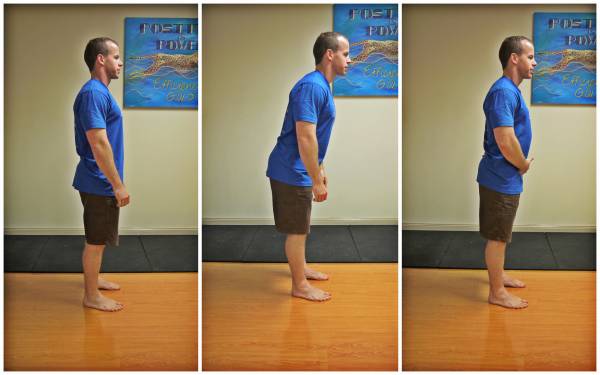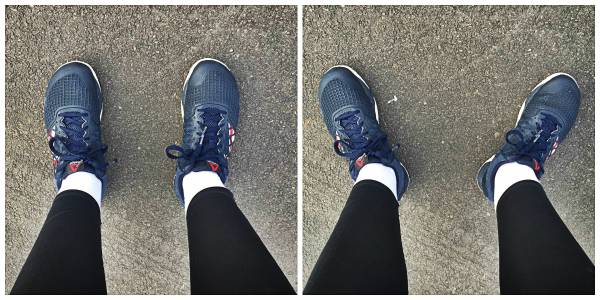Us humans are creatures of habit, and the postural positions you practice habitually have a huge influence on your running efficiency. You know you should be tall and not hunched over through your shoulders. You know your butt shouldn’t stick so far out behind you it’s still at mile 11 as you approach mile 12. Many runners avidly read, view, or are instructed on strong running posture.
But have you seen a photo or video of your running posture in the latter half of your run? You might often look like the Hunchback of Notre Dame wearing a 100-pound weight vest.
Fatigue can bring out the worst postures in runners.
If you were to look like this doing deadlifts or squatting, hopefully somebody in the gym would tap you on the shoulder and politely tell you how awful your technique is, and how likely you are to injure yourself. Unfortunately, the tap on the shoulder rarely occurs in running. Instead, there is a barrage of injuries that constantly beat you down.
Why the Other 23 Hours A Day Count
Have you ever considered the way you stand when you brush your teeth could lead to shin splints? Or your knee pain when running could be caused by staring at your phone while waiting in line for your coffee?
Rather than focusing on good posture for just an hour each day while you’re running, you need to practice strong, healthy joint positions the other 23 hours of each day too. I like to refer to these 23 hours as a dress rehearsal for how you want to look when running, as once fatigue sets in, you will fall into the posture your body accepts as “normal”.
My two biggest drivers of strong, efficient posture are head and foot position.
Postural Driver #1: The Head
Despite being a podiatrist, I always start with the position of the head. This is for two reasons. The first reason is because it is heavy. The big round bowling ball we call our head is designed to sit stacked above our torso. When your head drifts forward whilst standing, walking, or running, you have to counter this weight imbalance with your pelvis. As your butt drifts out behind you to offset your head being in front of your centre of gravity, your pelvis rotates anteriorly, and your glutes switch off. So your glute “weakness” when running may not be muscle failure – it may simply be position failure.
Try this simple test to understand how your pelvis position dramatically affects your glute activation.

- Stand tall with your feet underneath your hips.
- Squeeze your butt cheeks together tightly, like there is a $100 bill between them.
- Relax your glutes, stick your butt out behind you, then try again to squeeze your glutes.
- Notice how your glutes do not work nearly as well in this position.
You need to be mindful of keeping your head back on your shoulders to use your glute and torso muscles most effectively. Doing so regularly means your head will keep this position under fatigue. It’s way more effective than doing 1000 glute bridges a day only to have crappy head posture render those muscles useless anyway.
The second reason head position is so important is ground impact force when walking and running. As your head rolls forward into your “phone text messaging” position, your eyes become fixated on the ground almost directly in front of your feet. When you walk and run, this tends to direct your impact force more vertically and less horizontally. I like to refer to this as burrowing into the ground as you run, rather than gliding across the surface of it as you should. I find eye position to be a large factor in how heavy my patients and clients contact the ground.
It’s one of many factors influencing impact forces when we are active, but it is an easy one to modify: keep your eyes facing forward. There. You’re already looking more like the runner you want to be.
Postural Driver #2: The Feet
The next step is to think about where your feet should point when you run. I use numbers on a clock to reference where feet point when standing, walking, and running. If your feet are parallel, they point to 12 o’clock. If your feet turn out a little, they point to 11 and 1. Further out still, and they point to 10 and 2.

How your feet point when standing indicates how they will point in motion.
Why is this important? Let’s simplify your running muscle groups into prime movers and stabilisers. Let’s call your calves, hammies, quads, and glutes the prime movers, and the muscles down the sides of your legs, the stabilisers. When your feet point somewhere between 12 o’clock and 11 and 1, your prime movers will be positioned in a way to generate optimum forward progression, while your stabilising muscles can go about their job of adapting, moulding, and controlling inward and outward forces. Put simply, all your leg muscle groups do the job they are designed to do.
Now, as your feet turn out beyond 11 and 1 to 10 and 2, your prime mover muscles end up facing outwards and your stabilising muscles face forwards. This decreases performance capacity from your prime movers and places excess strain on your stabilisers by asking them to act as prime movers. This results in excessive stress on multiple body structures within your feet, ankles, legs, and onwards up the chain.
If you think of your feet as car tyres for your body, you will start to understand the importance of their position for running. If you put your car tyres on at any angle other than parallel, your car will not drive very well. It may move, and if you push the accelerator down hard enough, it may even move fast. But the wear and tear is far greater with every degree the tyres are turned out away from parallel.
There’s No One Size Fits All Here
The car tyre and feet analogy is pretty easy to understand, but human anatomy is not as simple. We have to accept there is no one size fits all for everybody. Not everybody will be in their optimum running performance position with their feet dead parallel. Complexities in bone and joint structure mean some runners will be in a more efficient and powerful foot and limb position with their feet at 11 and 1 compared with pointing to 12 o’clock. That said, I am yet to work with a runner whose optimum foot position sits outside of the 11 and 1 parameter.
“Become aware of where your feet point in the everyday activities and chores of life, as this will more often reflect the position of your feet when you run.”
There are also many activities and sporting endeavours outside of running that require a non-forward foot position, and forcing your feet to be in a parallel position for non-forward direction movements can leak power, energy, and performance for those activities. The rule of individual difference applies there as well, so be mindful with this prescription.
Position Is Power, Efficiency Is Gold
When fresh, running posture can be a chosen, strong position. But when fatigue sets in, running posture is determined by what your body accepts as normal. So if normal for you is head forward, eyes staring at your phone, shoulders slumped, and feet turned out like a duck, then it should not be a surprise that you run this way. As I’ve said before – changing your everyday postural habits is not easy, but the rewards are forever.
Be conscious of your head position and, wherever possible, stick it back on your shoulders where it belongs. Similarly, become aware of where your feet point in the everyday activities and chores of life, as this will more often reflect the position of your feet when you run. Remember: position is power – efficiency is gold. Your position is forged in the 23 hours of the day when you are not running, so start improving it in that time today.
More Like This:
- 3 Progressive Exercises to Correct Pelvic Tilt in Runners
- The Runner’s Guide to Loving Gravity
- Why There’s No Such Thing as Flat Feet
- New on Pulse Beat Fit
Teaser photo courtesy of Shutterstock.
Photos 1 and 2 courtesy of Tim Bransdon.
Photo 3 courtesy of Sam MacIntosh.






